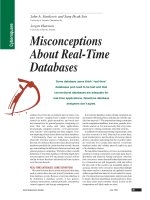Writing real time games for android
Bạn đang xem bản rút gọn của tài liệu. Xem và tải ngay bản đầy đủ của tài liệu tại đây (1.22 MB, 37 trang )
Writing Real Time Games
For Android
Chris Pruett
May 2009
3
Did You See That Awesome Fade?
•
Holy Crap!
–
The text was all sliding before that too.
–
How do they do that?!
•
Right, this slide is about me, the presenter. Chris Pruett.
That’s me.
•
I’m a Developer Advocate for Android.
–
That means I advocate development for Android. Please make
something. Maybe I can help you.
–
I work in Japan. 宜しくお願いします。
•
Before that, I wrote code for Lively.
•
Prior to working at Google, I made video games.
–
I shipped about 10 titles for lots of platforms: GBA, PS2, PSP,
Wii.
4
Making Games on Android
•
Writing games is awesome, and Android is awesome, so
writing games on Android must be awesome
2
.
•
This theory required testing. So I made a game. Many
lessons learned.
•
Topics to cover today:
– Why games? Why Android? I mean, besides awesome
2
.
–
Game engine architecture.
–
Writing Java code that is fast. For serious.
–
Drawing stuff on the screen efficiently.
–
Tips, tricks, and pitfalls.
5
Who Cares About Games on Mobile Devices?
•
Dude, what rock have you been living under?
–
iPhone: 79% of users have downloaded at least one game.
(According to a report by Compete, Inc.)
–
There are more than 100 million Nintendo DS devices
throughout the world. (According to Nintendo, see />2009/090507e.pdf)
–
Sony’s Playstation Portable has just passed 50 million devices
(see: />–
The Nintendo Game Boy and Game Boy Advance together
account for about 200 million devices (see />historical_data/pdf/consolidated_sales_e0806.pdf).
•
Portable games appeal to a huge audience, but traditional
phones have not been good game devices.
•
Game tech is extremely specific.
–
If your platform can support good video games, other apps
should be a walk in the park.
6
Why Games on Android?
•
Traditional PC and console game markets have been come
so high-risk that only a few companies can even compete.
•
Smaller games on non-traditional platforms are steadily
gaining popularity with both traditional gamers and folks new
to the medium.
–
See also: Nintendo Wii, iPhone, Flash, XBLA, etc.
–
Lower risk = more interesting and diverse content!
•
Android provides an avenue for innovative games across a
wide, internet-savvy audience.
7
Why This Game for Android?
•
My goal is three-fold:
–
To produce a fun game for Android.
–
To produce a reusable, open source game engine to allow
others to make fun games for Android.
–
To stress test our platform with regards to games; only
publically-available code and tools are to be used.
•
I went for an orthodox 2D side-scroller.
–
Parallax layers, tile-based worlds, animated sprites, etc.
–
Pushes all the right hardware buttons: input systems, OpenGL
ES, sound, etc.
–
Proper game is feasible with one 20% engineer (that’s me) for
six months and 1 full time artist for four months.
–
Tools are pretty easy to write.
–
Popular and recently under-served genre.
8
•
Topics to cover today:
–
Why games? Why Android?
–
Game engine architecture.
–
Writing Java code that is fast.
–
Drawing stuff on the screen efficiently.
–
Tips, tricks, and pitfalls.
Agenda 2: The Return
Insert Here: Picture of
man holding giant gun
that is also a chainsaw.
9
Quick Demo
(video goes here)
Note that this is a work in progress. All bugs are mine.
10
Game Engine Architecture
•
Lots of approaches, but the basic problems are similar.
•
My approach is a “game graph” that can be traversed every
frame, taking time and motion events as input and resulting
in a list of things to draw to the screen.
–
The root of the graph is the “main loop.”
–
Children of the main loop get called once per frame.
–
Children further down the tree might get called once per frame,
depending on their parent.
–
“Game objects” are children of a “game manager” node, which
only visits children within a certain activity bubble around the
camera.
–
Game objects themselves are sub-graphs of “game
components,” each implementing a single characteristic or
feature of the object.
MainLoop
InputSystem
GameObject
System
CameraSystem RenderSystem
11
Game Graph
MainLoop
InputSystem
GameObject
System
CameraSystem
Background
Game Object
Player Game
Object
RenderSystem
Scroller Component
Render Component
Scroller Component
Render Component
Scroller Component
Render Component
Player Component
Gravity Component
Movement Component
Collision Component
Physics Component
Sprite Component
Render Component
Animation Component
Layer 1 Layer 2 Layer 3
12
Game Graph
13
Game Engine Architecture
•
At least, that’s how I do it.
•
Important point: time is passed to each node in the graph so
that framerate independent motion is possible.
•
Second important point: this system collects things to draw in
a draw list each frame, but it doesn’t actually draw anything
to the screen.
14
Game Engine Architecture - Nice Threads, Yo
•
I have three threads:
–
The main thread spawned by the
Android activity.
•
Responsible for bootstrapping the game
and receiving input events.
•
Mostly dormant.
–
The game thread.
•
Handles all non-rendering parts of the
game: physics, AI, collision detection,
animation, etc.
•
Owns the game graph.
–
The rendering thread.
•
Controlled by a SurfaceHolder.
•
Just runs through its draw list and fires
off commands to OpenGL every frame
knows nothing about the game content.
Main Thread
Game
Thread
Rendering
Thread
Hardware
Blocking
Blocking
Input Events
Surface Holder
15
•
Topics to cover today:
–
Why games? Why Android?
–
Game engine architecture.
–
Writing Java code that is fast.
–
Drawing stuff on the screen efficiently.
–
Tips, tricks, and pitfalls.
Agenda III: The Series Continues
16
I Love Coffee, I Love Tea
•
I am pretty much a C++ engineer.
–
In fact, I wrote my first line of Java ever for this project.
–
So you should take my advice on the topic of Java-specific
optimization with a grain of salt.
–
Still, I have done a lot of optimization work in the last six
months, and maybe at a level that most Java apps do not
require, so maybe I can offer some useful tidbits.
•
Writing real-time games is an exercise in finding the perfect
balance between flexibility and performance.
•
My (non-language-specific) approach is:
–
Start with the simplest possible implementation, but design for
future rework.
–
Choose flexibility over speed every day of the week until the
gameplay is damaged.
–
Profile early and constantly.
17
Step One: Memory Management
•
Never allocate memory. Or release it.
–
Well, never allocate during gameplay.
–
The GC will stop your game for 100 ~ 300 ms. That’s death for
most real-time games.
•
Revised: Allocate as much as possible up front, don’t release
things until you have natural pause time. Invoke the GC
manually when you know it to be safe.
•
Use DDMS to track allocations.
–
Hey, Java allocates memory CONSTANTLY. Ugh!
–
Hidden allocations in things like enum.values(),
Class.getClassName(), Iterator, HashMap, Arrays.sort() etc etc
etc.
–
Some of these are not really avoidable.
18
Allocation-Related Java Language Contortions
•
Treat Java like C++
•
Lots of the standard Java utility objects allocate memory.
–
Collections are out, as are iterators.
–
Forget about enums (they are really heavy-weight anyway).
–
Arrays.sort() and similar functions
–
Anything returning a String that needs to be read-only (like
Class.getXXX(); man, I miss me some const).
•
DDMS is your tool to name and blame.
•
Better Java engineers than I might be able to supplement
existing frameworks with non-allocating implementations.
19
Step Two: Don’t Call Functions
•
Ok, that’s extreme. But function calls are not cheap and you
can’t rely on inlining.
•
Use static functions whenever possible.
•
Don’t call functions through an interface. 30% slower than
regular virtual functions!
•
Accessors and Mutators are my bestest friends in C++, but
they have no place in your Java inner loop.
•
Be wary of JNI functions.
–
In particular: lots of gl.glXX() functions.
20
Don’t Call Functions: A Graph
•
Take this with a grain of salt, not a very scientific test.
Local
Derived
Virtual
via Interface
JNI
Source: Some hack test I wrote under Android
1.1 and ran on my G1.
21
Step Three: Other Tips
•
Use local variables, especially in inner loops.
•
Use the final keyword on fields whenever you possibly can.
•
Some hardware (like the G1) has no FPU, so avoid float math.
•
Always use Log.d() or similar
rather than
System.out.print(). Printing
takes time!
•
Use Traceview!
22
•
Topics to cover today:
–
Why games? Why Android?
–
Game engine architecture.
–
Writing Java code that is fast.
–
Drawing stuff on the screen
efficiently.
–
Tips, tricks, and pitfalls.
Agenda Part 4: Even More Agenda
Screenshot from SpriteMethodTest, 1000
sprites, OpenGL DrawTexture extension.
Runs at around ~10 fps on the G1.
23
Android Drawing Methods
•
Canvas:
–
CPU-based 2D drawing. Used for most of the Android UI.
–
Fast for a small number of blits. (~ 10 sprites < 16 ms in my
tests)
–
Very straightforward and easy to use.
•
OpenGL ES
–
2D and 3D drawing.
–
Hardware accelerated on some platforms (like the G1).
–
Scales to much more complex scenes than Canvas.
–
Various 2D drawing methods:
•
Quads with orthographic projection
•
VBO quads (on supported platforms)
•
draw_texture extension (on supported platforms)
–
Only OpenGL ES 1.0 is guaranteed.
24
OpenGL vs Canvas for 2D drawing (G1)
10
50
100
500
1000
0 ms 91 ms 181 ms 272 ms 362 ms
draw_texture
VBOs
Basic Quads
Canvas
Source: Results of the SpriteMethodTest
application running on the G1 under Android
SDK 1.1.
25
Which Method is Best?
•
Clearly, OpenGL ES + the draw_texture extension is fastest
for 2D drawing on the G1.
–
But that extension isn’t guaranteed to be supported on all
platforms. You MUST check
glGetString(GL10.GL_EXTENSIONS) before using it.
•
However, Canvas isn’t bad if
–
You have very few things to draw every frame, or
–
You don’t have to draw every frame (puzzle games, etc).
•
SpriteMethodTest provides a framework for swapping
between drawing methods (and timing them) based on my
game code.
–
/>









